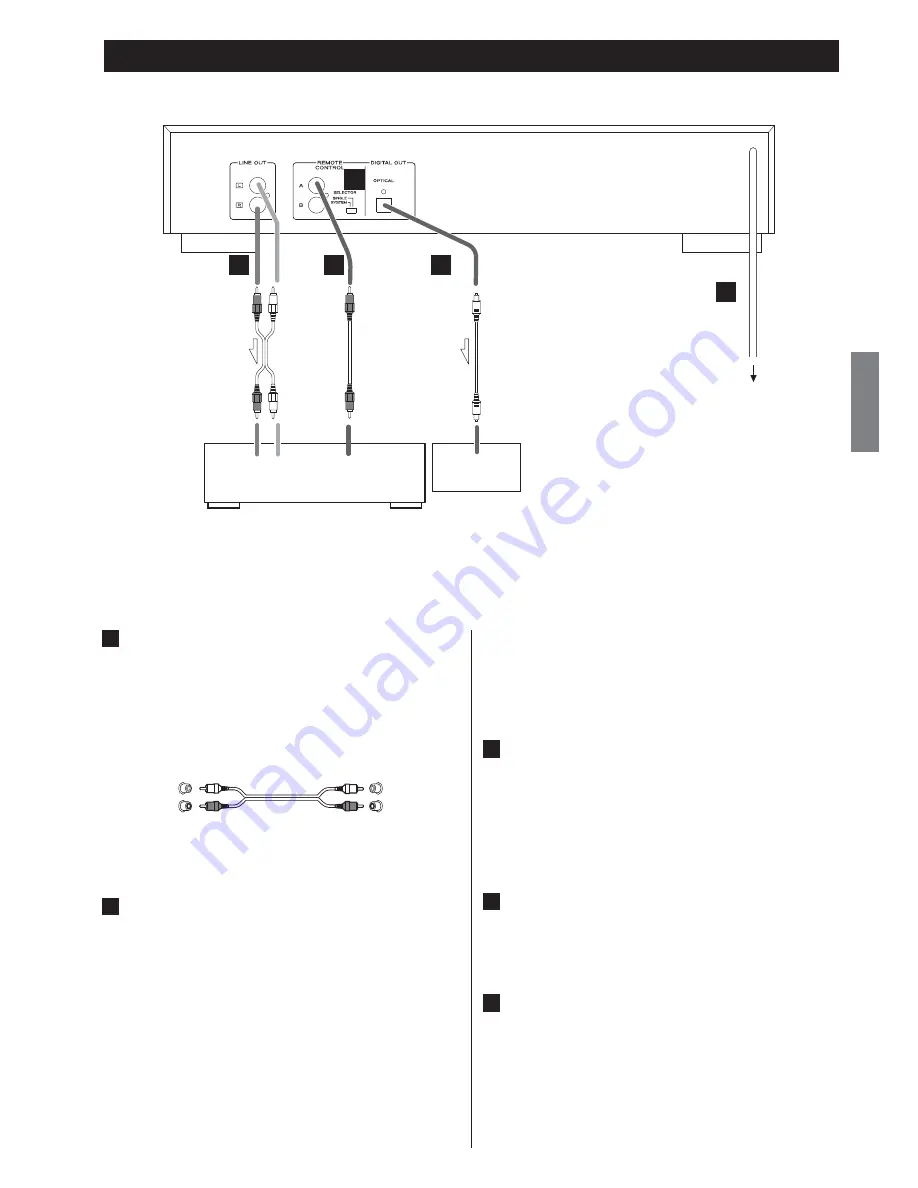
7
EN
GL
IS
H
Connections
(CD)
REMOTE
CONTROL
R
L
DIGITAL IN
OPTICAL
Amplifier (A-R650)
D/A converter, etc.
CD-P650
A
B
C
E
D
AC wall socket
CAUTION
<
Turn off the power of all the equipment before
making connections.
<
Read the instructions of each component you
intend to use with this unit.
A
LINE OUT jacks
These jacks transmit an analog 2-channel audio signal. Connect
these jacks to the TUNER jacks of the amplifier (A-R650) with a
stereo RCA pin cable.
Be sure to connect the cable as follows:
white plug
q
white jack (L: left channel)
red plug
q
red jack (R: right channel)
White
(L)
Red
(R)
White
(L)
Red
(R)
<
Be sure to insert each plug securely. To prevent hum and noise,
avoid bundling the signal connection cables together with the
AC power cord or speaker cables.
B
REMOTE CONTROL jack
If you have a TEAC A-R650, convenient system control operations
are available:
<
When you press the PLAY button, the input selector of A-R650 is
set to “CD” automatically.
<
When A-R650 is turned on while the input selector of A-R650 is
set to “CD“, playback of a CD will start automatically.
Connect the REMOTE CONTROL jack (A or B) to the REMOTE
CONTROL jack of A-R650 with the provided remote control
connection cord.
<
You can use the following buttons of the remote control provided
with TEAC A-R650:
CD (switch the function of CD-P650 between “CD” and “USB”)
When the function is “CD”:
PLAY/PAUSE(
t
/
J
), STOP(
H
),
.
,
/
, REPEAT, SHUFFLE,
TIME, Numeric buttons (1 - 0)
When the function is “USB” (also for playback of an iPod):
PLAY/PAUSE(
t
/
J
), STOP(
H
),
.
,
/
, REPEAT, SHUFFLE
C
SELECTOR switch
If the REMOTE CONTROL jacks of this unit and A-R650 are
connected with the remote control connection cord, select
“SYSTEM“. You can use the remote control unit provided with
A-R650, and convenient system control operations will be
available.
When you don’t use the system control operations, or you don’t
have an A-R650, select “SINGLE“.
D
DIGITAL OUT terminal (optical)
Digital 2-channel audio signal is output from this terminal.
Connect it to the digital input terminal of a digital device such as
a D/A converter, etc.
Use a commercially-available optical digital cable.
E
AC power cord
After all other connections are complete, connect the plug to
the AC wall socket.
<
Be sure to connect the power cord to an AC outlet which
supplies the correct voltage.
<
Hold the power plug when plugging in or unplugging the
power cord.








































